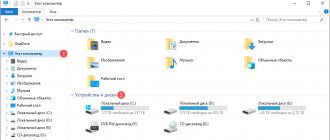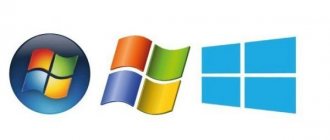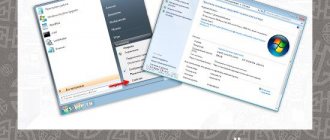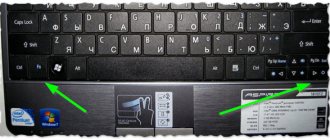Every user should know the characteristics of their PC. This knowledge is important before installing applications (games). Each application has its own requirements for the power of computer components. If your PC cannot handle, for example, a game according to its parameters, then there is no point in installing it; you will waste your time and nerves.
It is not uncommon for PC components to fail. Knowledge of PC specifications will help you choose the right compatible parts to replace broken ones. In general, many users are simply interested in knowing the inside of their computer. In this material we will look at how to view the characteristics of a computer running Windows 10. Typically, characteristics mean information about the following components:
- Laptop model;
- Operating system;
- Motherboard;
- CPU;
- Video adapter;
- RAM;
- Disk (HDD, SSD);
- Other components.
Computer properties
Brief information about the PC configuration is contained in one of the Settings
(formerly
System Properties
).
- Open directory properties This computer
right-click on the shortcut. - In the window System
You can get information about the processor and amount of RAM on your computer.
Second way.
- Press the Win + i keys to open the Settings
; - Visit the section "System
»; - Scroll to the bottom of the menu and go to the subsection "About the system
» («
About the program
» assembled
20H2
); - A window will open in which you can see the basic parameters of the PC: processor model and frequency, amount of RAM. If this information is not enough, follow the instructions below.
View in Task Manager
Open Windows 10 Task Manager. Visit the Performance section. On the left, click on “CPU”, in the right area you will see the characteristics of the processor, as well as its performance.
Immediately below the “CPU” is “Memory”. This is exactly RAM. Immediately under the inscription “Memory” you can find out the amount of RAM. When you click on this section you will see more detailed information about RAM.
The next parameter “Disk” checks the operation of the HDD or SSD. Here you can find out the total disk space.
The “Graphics Processor” section allows you to find out the name of your video card. Other information about the video adapter is also displayed here.
Task Manager allows you to view the main characteristics of your computer. The manager in Windows 10 also helps track the level of use of PC components.
device Manager
One of the elements of the MMC snap-in, which collects data about peripheral and system devices of the computer. Opens in several ways. Let's consider one of them.
Hold down the Win + X keys and select Device Manager
:
Hardware in Device Manager
ungrouped, the tool will show names, operating modes, driver versions and much more about each computer component. Including about virtual devices, unused (disconnected), connected drives, smartphones.
More data is provided in the component properties (double click on the name).
Useful utilities for viewing computer settings
Most standard services reveal a meager list of PC characteristics - only the main ones are indicated. If you don’t have enough information even in the “System Information” window, download and install a special utility that will display the missing details. Let's look at working in the most popular third-party applications of this type.
CPU-Z: a utility with the ability to test the CPU and an interface in English
CPU-Z is a simple utility for viewing the technical characteristics of a PC, video card, processor, motherboard. Let's talk about its strengths:
The main significant disadvantage of the utility is that it does not show information about the hard drive. The program also does not overclock the processor (this option is enabled in many other competing programs).
On the official resource you can download only the English or Chinese version of the program. The Russian-language version can only be found on third-party resources, where other users can upload an installer with a translated interface to the network. However, if you decide to download an unofficial utility, be very careful not to download a virus along with the application. We will consider downloading and using only the official version:
Video: How to use the CPU-Z application
Speccy: Russian interface and hardware temperature
Speccy is a product from a British developer called Piriform: lesser known than CCleaner, but just as useful. The free utility is able to obtain information regarding all hardware and software components of your computer: from the processor and hard drives to the network and sound devices. The application shows the temperature of some components. At the same time, in the program itself you can change the interface language, for example, to Russian.
The utility allows you to save information about your PC in a separate text document or in an xml file. There is also an option to quickly print information on a printer without saving the file. Another advantage of the program is that it displays the processes of utilities that use the Internet on a PC.
Perhaps the only disadvantage of this program is that during installation you may be offered to install additional software, for example, an optimizer. You can refuse this setting.
The developer offers a choice of regular and portable versions. The latter is different in that it does not need to be installed on a PC - just run the file downloaded from the official resource. We'll tell you how to download the portable version and use it:
Video: review of the Speccy program
AIDA64 Extreme: paid detailed service
AIDA64 Extreme is a multifunctional product developed by FinalWire. Let’s say right away that the utility is not free. The Extreme version costs about $40, but every user can use it for free for the first month. The program really has something to boast about: it provides accurate and detailed information about all hardware and software components of the PC, which can be packaged in a separate txt text file or in an html or mhtml document.
The user of this application can not only find out detailed information, but also immediately visit the official website of this or that equipment to check whether an update for the driver or software is available. In the utility window you can test the hardware of your PC.
The program is suitable not only for professionals, but also for beginners: it has a clear interface in Russian (the language can be changed to another in the settings).
There are two versions of Extreme: regular (with installation of the utility on a PC) and portable. The latest version is the easiest to use, so let's download it:
Video: overview of the AIDA64 utility
If you need to get only basic information about your PC and operating system, use standard tools: the “System” section in the “Control Panel” or in “Windows Settings”. More detailed information is provided in the System Information window and the DirectX diagnostic service, as well as in special third-party utilities. The most convenient and accessible is the Speccy program. It allows you not only to familiarize yourself with the parameters, but also to see the indicators of the current operation of the components. Moreover, it is free. AIDA is a paid utility, but it helps you change settings in the operating system and contains links to the official resources of equipment manufacturers where you can download the update.
Source
msinfo32 system information
Standard information utility System Information
or
System information
is called by the msinfo32 command on Windows of any version in the “
Run
” window (Win + R combination), search bar or from the Start section “
Administrative Tools
”.
There is little data in the main window: processor, motherboard model, total amount of RAM. In the " Components"
» you will find a summary of ports, drives, input and output devices, and peripherals.
The search bar below will filter the desired results by key phrase.
The contents of the windows are exported to a text document in txt or nfo format via the main menu item “ File”
"
To save a specific section, for example, “ Storage devices
,” click on it.
Find out basic information using the standard Settings application
If you want to see a basic overview of your system, you can find it in the standard Settings
, both Windows 8 and Windows 10. To open the application, click
“Start”
and then click on the
“Settings”
(gear icon) in the lower left corner of the window, or press the keyboard shortcut
“Windows + I”
.
Next, in the application, click on the “System”
.
After that, on the page that opens, go to the “About the system”
in the menu on the left.
Three sections with information will be displayed on the right side of the window. In the first, information about the protection of your PC in real time will be shown in the “Device Characteristics”
Provides basic information about your PC's configuration, processor model, amount of RAM, device and product IDs, and the type of system you're using (32-bit or 64-bit).
In Windows Features
shows the name and version of your operating system, installation date, and Windows build number.
Also in this window you can follow the links: update the key and reactivate the OS, read the license agreement and the agreement for the use of Microsoft
.
Dxdiag
DirectX Diagnostic Tool
displays brief information about the PC components: processor, motherboard, video card, monitor, sound subsystem, amount of RAM.
Explorer address bar
.
On the Screen
» displays information about the video card: its manufacturer, model, amount of video memory, operating mode.
On the “ Input
” tab you will find information about input devices and equipment connected to USB interfaces.
Dxdiag exports the summary to a text file (in English).
Additional utilities
Of course, there is a wealth of third-party paid and free software available on the Internet that can provide even more specialized information.
For example, if you reinstalled the operating system, and the new OS did not install the necessary drivers for all necessary devices, and they are not displayed correctly in the Task Manager
or are not operating at full capacity.
In such a situation, free software can help - “CPU-Z”
. You can easily download it from the official website of the developers.
The program will scan your system and display the most complete information about the configuration of your PC, even without installed drivers. Information about the motherboard, processor, RAM and slots for it, information about the video card, the program will allow you to test the performance of your processor and compare its results with others. It will also provide the opportunity to save the full report in a text or “html file”
.
You can also take a closer look at the HWMonitor
is a great tool for monitoring various aspects of your system, such as CPU and GPU temperature and voltage.
The Sysinternals Suite
is a collection of over 60 individual utilities that can provide you with an incredible amount of information.
And also “AIDA64”
- a program that will help test and identify devices connected to your PC. It will also provide detailed information about the hardware and software installed on the PC. As I already said, there are a whole lot of them, and each can be useful in a given situation.
Source
Command Line and PowerShell
System Information utility
can also be called via the command line.
- Launch the cmd console through the Win + R window:
- Run the systeminfo command.
After a couple of seconds required for analysis, you will see some of the information that the MSInfo32 application displays. It can be copied to the clipboard; to do this, right-click on the window header and select the appropriate command: for the first time “ Select all”
” (alternative to Ctrl + A), in the second - “
Copy”
.
The tool, like other system tools, will not display the number of installed RAM sticks, only its total volume. It won't tell you anything about the video card. The same utility works with PowerShell.
How to view the full specs of a Windows 10 PC
There are several ways to find your PC's full specs in Windows 10. Here's how:
- Using the Settings app
Use Settings to see your Windows 10 computer's specifications.
The Windows 10 Settings app is the easiest and best way to find out the complete specifications of your PC. Here are the steps to check it:
- Open the Settings app using the Windows key + I.
- Select the "System" category.
- Scroll down the left panel and select About.
- On the right side, you will see all the details such as device specifications, Windows specifications and other related settings.
Using the Run command
Alternatively, you can open the Run dialog box and run the DirectX Diagnostic Tool to directly open system information.
- Right-click the Start button and select Run.
- In the text box, type dxdiag and press Enter.
- The DirectX Diagnostic Tool window will open where you can see all the details such as display, sound and other information. Just go to the appropriate tab and see the details.
Checking system information
The System Information window is another way to see all the details about your computer. Here are the steps to check the specifications.
- Click the Search button and enter System Information.
- Select the same from the top of the result.
- In the System Information window, you can find all the information about your Windows 10 PC such as hardware resources, components, software environment.
Characteristics via command line
Apart from the above methods, you can use a simple command to check the complete specifications of your Windows 10 PC.
- Run Command Prompt as Administrator.
- In the Command Prompt window, type systeminfo and press Enter.
- It will take 2-4 seconds and then all the information about your Windows PC will appear on your screen.
Third party programs
Built-in Windows 10 tools display incomplete information about the components of a personal computer and will not tell you anything about the number of RAM modules. Making a meaningful report with them is also problematic. To get advanced viewing options for your PC configuration, you need to use a third-party utility. There are free programs for these purposes: Speccy
,
CPU‑Z
,
HWInfo
and others, let’s focus on the last one.
HWInfo
The application consists of three modules:
- Brief information about the system - basic information about hardware components is collected in one window. Including information about each stick of RAM – section “ Memory Modules
" and about connected hard drives - "
Drives
». - Main window – groups of devices are displayed in the form of a tree on the left, detailed information about them is displayed on the right.
- Data from sensors - readings from temperature, voltage, cooler rotation speed, RAM, CPU and GPU cores.
In HWInfo you can create and export reports on selected devices (item “ Report
" in the main menu).
How to find out the characteristics of a laptop: review of services
If you somehow cannot find out the characteristics of your computer using built-in tools, then use additional services. These are special programs that help monitor the condition of the laptop and provide information about its characteristics. Some developments provide even more information than standard solutions, including the number of OS crashes and blue screens.
AIDA64 Extreme
AIDA64: YouTube/Pavel Mudry
This is a very convenient program that has a portable version (does not require installation on your computer). It shows absolutely all the information about the computer down to the smallest detail. According to it, many users monitor the temperature of components in order to prevent overheating in time.
Using AIDA64 Extreme is easy:
- Install on your PC or download the portable version.
- Launch the program.
- Find the required information in the appropriate section on the right.
AIDA64 is also available for mobile devices.
PC Wizard
Another program that shows a full range of data about the characteristics of a laptop. It works the same on all versions of Windows.
How can I view my computer's specifications using PC Wizard? Follow these steps:
- Install and run.
- Use the menu on the right to find the necessary information about your PC.
Users note one minor drawback of PC Wizard. The program sometimes slows down and thinks for a long time (sometimes the waiting time reaches 10 seconds). It would seem that this is not much, but with frequent use such expectations become annoying.
Piriform Speccy
This is free and one of the best programs for viewing PC technical parameters. Let us immediately highlight the following advantages of the development:
- there is a portable version;
- works not only on laptops, but also on desktops and netbooks;
- completely in Russian.
Piriform Speccy works on the same principle as previous programs. Install, run, and find the information you need. The utility shows all PC and OS data in full. With its help you will learn:
- model, frequency, temperature of the processor and video card;
- information about maternal memory;
- operating system version;
- monitor extension;
- volume and full name of the hard drive or solid-state drive;
- RAM information.
CPU-Z
CPU-Z: YouTube/Tutorials Online
If you need to find out detailed information about the device’s processor, the CPU-Z program will help. It is completely free and is aimed at analyzing the performance of the central processing chip. With its help you can understand the state of the DAC.
The program also shows information about the motherboard, RAM and video card. To find out information, download the portable version and run the program.
GPU-Z
This is an analogue of the previous development, but this version is tailored for a video card. It displays detailed information about the video chip. You can find out the model name, bus type, bandwidth, data transfer speed, amount of video memory and much more.
The Sensors section displays the temperature of the video card and processor, percentage of fan speed, used video memory, and more.
Thaiphoon Burner
The previous two programs are focused on the processor and video card. But what about RAM? If you need to know all the ins and outs of RAM, then install Thaiphoon Burner.
The program reads SPD data, which stores absolutely all information about RAM. This program is suitable for those users who need to know RAM timings, chip manufacturer, detailed memory information and much more. To use it, install and run.
Thus, you can find out the characteristics of a laptop using standard methods or using additional software. The latter provide more extensive information, which helps when searching for replacement parts or preventing overheating or component failure.
Original article: https://www.nur.kz/technologies/instructions/1782696-kak-uznat-harakteristiki-noutbuka-raznyh-modelej/











